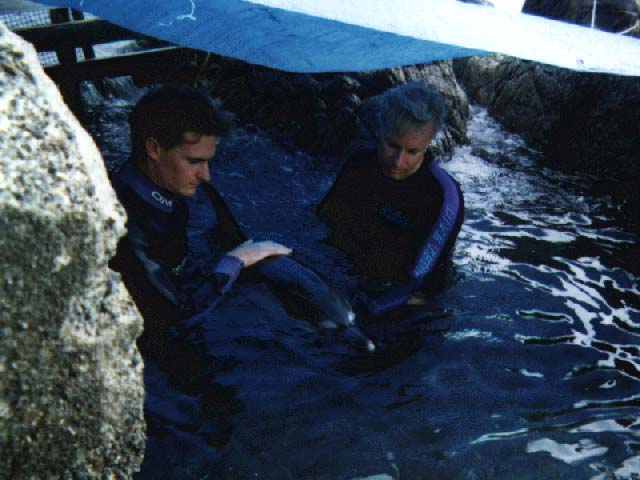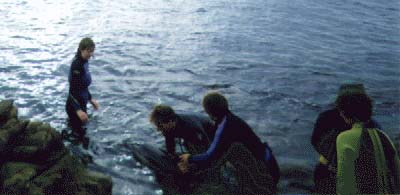 Cleo
Cleo Cleo
CleoTop of the morning to our fans world-wide.
We know how keenly you are awaiting another wondrous animal story from Down Under - here it is.
On a fine wind-still day recently a 1.5 metre long young dolphin was caught in a set net in the Wellington Harbour. When released, the dolphin's sense of balance was impaired and it was near death. Members of the Little Blue Penguin Foundation when they were asked to care for it, knew they faced their biggest challenge yet. But I can modestly report that we rose to the occasion.
By a happy coincidence it was the weekend and volunteers with wetsuits were found at short notice. After enduring a 4 kilometre ride in a truck, the dolphin was gently lowered into shallow water, where it was cradled on the arms of two rescuers while a third one held onto the powerful tail.
Initially all three people were relieved hourly, but when we noticed the change in people distressed the dolphin, only one person at a time was replaced.
Our vet Steve Robb, who gives his Services to the Foundation free, also arrived pronto. He managed to inject some vital medication into the dolphin's tail, but our efforts to feed the patient failed. The dolphin courteously but determinedly spat every thing out.
Earlier in the day an awning was erected to prevent the dolphin from being sunburnt, while it's mental well-being was assisted by soft voices, gentle stroking and the soothing tones of Bach and Albinoni on a nearby tape-recorder. A bucolic setting indeed, and by and by our efforts were rewarded when the dolphin relaxed and recovered sufficiently to start up it's sonar.
At 2am on a blissfully serene Sunday morning, 15 hours after the dolphin's arrival, we decided to try and release him. Marshalling all our strength we first towed him in shore a little and then gave a powerful push forward. Whoosh!!!
Its response was better than we had dared hope. With a graceful leap the dolphin was away and out of sight into the night. Not trusting our luck we patrolled the adjoining bays for an hour afterwards to ensure the dolphin had not washed ashore again, but the coast was clear. It's amazing how many people are about at that time of night wanting to know if you have lost anything!
So far the story is remarkable enough, but its sequel makes it truly magical. At daybreak that same morning the whole pod of dolphins appeared and played around for 30 minutes behind the penguin sanctuary where the youngster had been nursed back to health. Their antics were recorded on video and when last seen our friends of the deep were heading out towards Cook Strait and the open sea.

ADMISSION DETAILS
| Species: | Common Dolphin "Dolphinus Delphis". | ||
| Date Captured: | 6 January 1996 | ||
| Location Captured: | Lowry Bay | ||
| Person Reporting: | Ivan Morrison - Department of Conservation | ||
| Band Number: | N/A | ||
| Admission Weight: | Unknown | ||
| Release Weight: | Unknown | ||
| Date Released: | 7/1/96 | ||
| Sex: | N/A (Juvenile) | ||
| Rehab Unit No: | M001 "Cleo" | ||
| Description: | Blackish-grey back with brown markings. White underparts. | ||
| Condition/Injury: | Abrasions - new ones under belly from rocks. Old scar tissue on back in the shape of net markings. Diarrhoeah. Water in lungs. Very weak and unable to float - kept rolling to side. Mucus discharging from its eyes and one eye was completely closed, the other only partially open. Hot to touch and very distressed. | ||
FOOD
| In Captivity: | Fish | ||
| In Wild: | Fish | ||
![]()
LIVING QUARTERS
| Location: | Marine pen in rock pool | ||
TREATMENT DETAILS
| 6/1/96 | 10:30 DOC called and asked if we could
take a dolphin that had been washed up on Lowry Bay Beach. They arrived
asking for towels and blankets.
11:00 The dolphin arrived on the back of the DOC truck. They had covered it with wet towels and blankets. Backed into Tony and Dawn Cowdrey's yard and transferred it to a pen made out of the Albatross cage and the rock pools. The dolphin was unable to support itself in the water and was very distressed. It was gasping rapidly and squealing. The skin appeared hot to touch. Mucus was discharging from its eyes and one eye was completely closed. The other only partially open. Two people held the dolphin afloat in the water on either side. Air from blow hole foul to smell. Roster made up from Rosalie Goldsworthy, Viv Hextall, Dot, Bernice Elvy, Steve, Tony Cowdrey, Ruth Watson, Mike, Graham and Wendy Bentley. 12:00 Steve from Taita Veterinary Clinic arrived. Administered clavulox and steroids via injection in tail area. It was very difficult to insert the needle and the needle holes kept leaching. Localised pressure was applied to prevent this. This was the treatment as advised by Marineland Napier. Dolphin supporters changed hourly. Tarpaulin erected over the dolphin to prevent sunburn. 15:00 Steve arrived to check the vital signs. Heart rate and breathing had considerably improved. He was still concerned with the level of dependence the dolphin had to keep itself afloat. It was still unable to maintain it's own buoyancy. The tide and wake from boats caused a few problems for people in retaining their balance. Harbour police requested to keep boats out of the area and also to ask the fast ferry Lynx which has a large wake to slow down. East by West Ferry Service also asked to avoid the area. Visited by Lady Liz the police launch. 18:40 Dolphin guided into open water as the sun had gone down. It was easier for the people to hold the dolphin afloat if they were able to stand in open water. The sea was very calm. Within 15 minutes of being moved into open water the dolphin began intermittently to use its sonar clicks, made several half hearted attempts to lunge, however on rolling over on it's side it soon became passive again and willing accepted the support of the people rostered on. Hourly roster changes continued into the night. Sonar clicks are definitely related to the direction he was pointed in. ie: only came on when he was facing open water. When his sonar came on all the little fish in the vicinity leapt out of the water at a great rate of knots. We noticed that he became distressed at the changed over in the roster. We decided to overlap 1 person by 30 minutes to provide more continuity for the dolphin. This worked well. 21:00 Taken to the boat ramp and given Ivomec and Clavulox. This time intra-muscularly in behind the dorsal fin. Local pressure applied to prevent seepage. The needle was easier to put in at this point. No visible sign of distress from the injection. Steve advised to continue the current regime we were using, and that the dolphins vital signs had improved - his body temperature had also dropped. Horizontal stability had also improved. 23:00 Dolphin able to stay level in the water. Music played to keep him calm. Sonar operating now most of the time. |
||
| 7/1/96 | 02:10 The dolphin was given a nudge
forward without support in the water towards the harbour entrance. His
stability had improved markedly. He flicked his tail but stopped when he
saw a person ahead of him. He went approximately 2 metres. We tried again
and this time gave him a clear run. He leapt partially out of the water
flicked up his tail and swam out to sea.
06:30 While feeding the penguins Rosalie and eye were treated to a swim past by a pod of approx 60 dolphins - they swam in circles and up and down in front of the house. -Turned and swam out to sea. Maybe it was their way of saying thank you. One of the very special and privileged moments in life. 16:30 Dolphin sighted playing in the bow waves of a small boat on the city side of the harbour. Positively identified by the criss-cross markings on his back. |
||

RELEASE DETAILS
| 7/1/96 | 02:10 Released in open water from the seawall at 4a Marine Drive, Days Bay. | ||
Last updated: October 24, 1999.
This page is maintained by Luke McCrohon..
Copyright © 1996 - Charlie Lear
Wellington, New Zealand